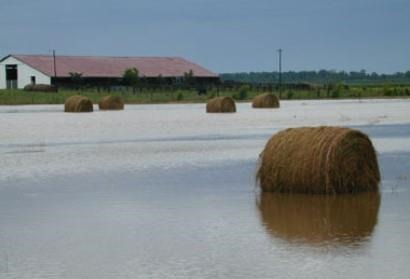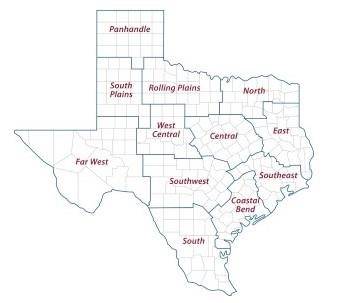Rains and the threat of rain have kept forage producers in hay-producing regions of the state out of fields and behind schedule for the season, according to a Texas A&M AgriLife Extension Service expert.

Hay bales in a flooded field near Bryan-College Station. Forage producers have had a tough time finding windows to cut, cure, bale and put up hay crops between rains. (Texas A&M AgriLife photo)
Delays represent numerous problems and potential problems for hay producers.
Two months ago, drought was the main concern for Texas forage producers who cut and bale warm-season crops like Coastal Bermuda grass to feed their cattle during the winter or market to livestock operations near and far.
But too much rain has been the chief concern among forage producers in the eastern half of the state for more than a month, said Vanessa Corriher-Olson, Ph.D., AgriLife Extension forage specialist, Overton. Hay meadows with fences and a water source were likely grazed out, but the majority of production acres don’t have those resources available.
“The inability to access fields is the main concern,” Corriher-Olson said. “Fields are too saturated. You can get stuck in a regular truck in well-drained, sandy soil so it makes getting in with heavier equipment to cut and bale or apply fertilizer or herbicide very difficult.”
Some producers were able to get a first cutting baled before the rains settled in, she said. Some were able to cut and rake their hay into windrows, but rains came before the cuttings could cure.
Curing, the process in which cut hay dries down, is a critical balancing act that preserves the plant material and nutritive value and prevents potential losses. Too much moisture can promote two major problems in hay bales – mold, which spoils it as forage for livestock, and heat, which can make tightly wound bales extremely combustible.
The haying process can take one to three days depending on weather conditions like temperature, cloudy or sunny skies, or wind and humidity levels. Hay in windrows can dry quickly on sunny, arid and breezy days but could take longer during cloudy, humid and still conditions.
Corriher-Olson said forecasts have not provided good windows of opportunity for the process.
“Access is the biggest problem, but even the producers who can get in their fields might be looking at a forecast with chances of rain for multiple days each week,” she said. “They either have to risk it or wait. But it’s hard to make decisions with rain in the forecast every day.”
Forage producers could still maximize on hay season
East and Central Texas produce the bulk of the state’s hay supply, but how the torrential rains and subsequent lost cuttings may impact the state’s hay stores this winter will depend on weather throughout the rest of the season.
Some bales are shipped to drier regions of the state or outside Texas to parts of the country dealing with drought, she said.
The soil moisture has created an excellent soil moisture index for hay-producing parts of the state that Corriher-Olson said could, with a few timely rains, carry good hay production into October. The storm systems have also greatly improved soil moisture conditions in drier parts of the state, which will likely reduce their need for supplemental feed until winter.
Depending on the frost date, the potential for multiple cuttings is still there, she said. But producers need to be prepared to pounce on any opportunity to work their hay meadows.
Many fields still contain volunteer cool-season forages like ryegrass because producers missed the opportunity to remove them, Corriher-Olson said.
“Getting rid of cool-season grasses like ryegrass is important to give our warm-season grasses the opportunity to emerge and grow,” she said. “There is good soil moisture and we want to take advantage of that, so taking care of that first cutting and following with a fertilization will help tremendously.”
Beyond timely cutting and baling every three to four weeks when nutritive values peak, Corriher-Olson said fertilization, weed control and pest management will be critical to maximizing forage production this year. Finding access to less expensive alternative fertilizers like chicken litter is an option to avoid high prices on traditional products like ammonium nitrate.
Utilizing herbicide applications properly and timely will help efficacy rates, and scouting for pests like fall armyworms and grasshoppers and acting quickly when they near thresholds could save crops.
“This year it’s going to be very important to be prepared and take advantage of any window of opportunity we have,” she said. “The current state of production is not as bleak as it was in early April. It’s difficult right now, but hopefully we get opportunities for curing and to put some bales up safely. There should be plenty of warm days ahead.”
AgriLife Extension district reporters compiled the following summaries:

CENTRAL
Rain and wind occurred most days with continued saturated conditions and considerable flooding. All counties reported surplus soil moisture levels. Rain was in the forecast. Winter wheat and oats were mostly too wet to harvest, and oat stems were beginning to collapse. Corn farmers appreciated the rain. Pastures and fields were extremely wet but looked good, though some much-needed sunshine would help. No cotton or peanuts were planted. Livestock were in good condition, and ranchers were still shipping stocker cattle off winter grazing. Cooler-than-normal temperatures remained.
ROLLING PLAINS
Counties reported 2-4 inches of rainfall. Lakes and tanks could use more runoff to fill. Conditions were too wet for fieldwork in some areas. Sudan grass was planted, and producers were about to start the wheat harvest. Wheat and oats were headed out and in poor shape for grazing, and excess rains have producers concerned about timely harvests to make way for hay production. Pasture conditions were improving. Wet conditions were delaying cotton, sorghum and haygrazer plantings and fertilization of pastures.
COASTAL BEND
Rain and wet conditions prevailed with some areas receiving up to 6 inches. All grain crops were doing well except those in standing water. Most production practices slowed due to excessive soil moisture. Wheat was past time for harvest and shattering was expected. Hay fields needed to be harvested. Rice was doing well. Weather conditions continued to delay herbicide applications on pastures. Rangelands and pastures improved, providing plenty of grass for livestock. Livestock were pulled from bottoms with localized flooding, and low areas may need minor to significant repairs. Livestock auctions slowed.
EAST
Heavy rain remained a concern for producers who have not been able to access fields to fertilize or cut hay in most areas. Subsoil and topsoil conditions were surplus. Houston County reported dam breaks and flooding in a good portion of the county, as well as the north end having received 11 inches of rainfall over a single night. Harrison County reported only one hay field that had been cut, and it was rutted up from equipment getting stuck. Pasture and rangeland conditions were good. Fertilizer prices were higher than last year. Cattle prices were still low. Livestock were doing fair to good. Horn fly and stable fly populations were on the rise.
SOUTH PLAINS
No report.
PANHANDLE
Timely rains improved the soil moisture profile, benefitted the maturity and yields of winter small grains, and improved emergence of recently planted crops. Northern parts of the district reported adequate soil moisture levels while central and southern areas reported short to adequate moisture levels. Winter wheat, pasture and rangeland conditions were fair to excellent. Corn was in good to excellent condition. Cotton conditions were fair to good.
NORTH
Topsoil moisture throughout the district was surplus. Rainfall amounts were 1.5-2.5 inches. Moisture levels were making it challenging to access fields for unharvested wheat, which was becoming a big concern due to soil saturation. Corn was starting to become oversaturated and turn yellow in places. Some cotton acres will not be planted as the wet conditions prevented access before the insurance planting deadline. Many producers continued to wait for their first hay cutting and have not put out fertilizer and herbicide due to rain and saturated soil. Insect management on livestock has become a challenge due to moisture as well. Ticks were reported on the cattle for the first time in years.
FAR WEST
Temperatures reached 105 degrees with low temperatures in the mid-50s. Hot temperatures could dry up recently received moisture. Isolated areas received between 2-4 inches of rain, but most areas received only trace amounts of rain in quick bursts. Some areas experienced hail and damaging winds. Fire danger was still high. Livestock were still receiving supplemental feed or being sold due to drought. Working of goats and late lambs finished up.
WEST CENTRAL
The district received a good widespread rain. The rainfall and previous rains have dramatically improved rangeland, pasture, and corn and sorghum conditions. Wheat harvest continued to be stalled due to wet conditions but was expected to resume in the coming days. Livestock were in good condition.
SOUTHEAST
Some areas received heavy rains. Pastures and crop fields were holding water. Some rice plantings were delayed by wet conditions. Excessive rainfall was taking a toll on animal health with cases of foot rot, pneumonia and colds being reported in livestock. Rangeland and pasture ratings were very poor to excellent with good ratings being the most common. Soil moisture levels were adequate to surplus with surplus amounts being most common.
SOUTHWEST
Rainfall ranged from 0.75-5 inches across the district. Rains were improving rangeland and pasture conditions. Wheat and hay harvests were delayed due to wet weather. Unharvested wheat was sprouting and won’t be suitable to harvest in some areas. Corn and sorghum were in good condition. Livestock were in fair to good condition.
SOUTH
Scattered showers continued throughout the district. Soil moisture levels were adequate in most areas. Many areas received heavy rains with reports of 3-9 inches by several counties. Parts of Kleberg and Kenedy counties reported 21 inches of rainfall for May. Wheat and oat harvest was completed in most areas, and in good condition in areas awaiting harvest. Potato and sweet corn harvest continued but were delayed by rains. Cotton was planted and emerged fields looked good, but some early planted fields were starting to turn yellow and dropping squares in fields with standing water. Corn fields were in the silking stage. Peanut fields looked good. Sorghum fields were heading and looked good. Row crops should benefit greatly from recent rains. Soybeans were emerged to blooming and looked good. Cantaloupes and watermelons were in good condition, and Coastal Bermuda grass was progressing well. Sunflowers were planted. Rangeland and pasture conditions improved significantly. Rivers and creeks were flowing, and water flooded some roads. Tanks were full.
Source : tamu.edu